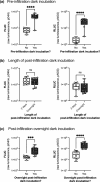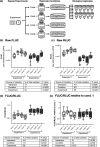Critical parameters for robust Agrobacterium-mediated transient transformation and quantitative promoter assays in Catharanthus roseus seedlings
- PMID: 38855128
- PMCID: PMC11154794
- DOI: 10.1002/pld3.596
Critical parameters for robust Agrobacterium-mediated transient transformation and quantitative promoter assays in Catharanthus roseus seedlings
Abstract
Agrobacterium-mediated transient expression methods are widely used to study gene function in both model and non-model plants. Using a dual-luciferase assay, we quantified the effect of Agrobacterium-infiltration parameters on the transient transformation efficiency of Catharanthus roseus seedlings. We showed that transformation efficiency is highly sensitive to seedling developmental state and a pre- and post-infiltration dark incubation and is less sensitive to the Agrobacterium growth stage. For example, 5 versus 6 days of germination in the dark increased seedling transformation efficiency by seven- to eight-fold while a dark incubation pre- and post-infiltration increased transformation efficiency by five- to 13-fold. Agrobacterium in exponential compared with stationary phase increased transformation efficiency by two-fold. Finally, we quantified the variation in our Agrobacterium-infiltration method in replicate infiltrations and experiments. Within a given experiment, significant differences of up to 2.6-fold in raw firefly luciferase (FLUC) and raw Renilla luciferase (RLUC) luminescence occurred in replicate infiltrations. These differences were significantly reduced when FLUC was normalized to RLUC values, highlighting the utility of including a reference reporter to minimize false positives. Including a second experimental replicate further reduced the potential for false positives. This optimization and quantitative validation of Agrobacterium infiltration in C. roseus seedlings will facilitate the study of this important medicinal plant and will expand the application of Agrobacterium-mediated transformation methods in other plant species.
Keywords: Agrobacterium tumefaciens; Agrobacterium‐mediated transformation; Catharanthus roseus; luciferase; transient expression; vacuum infiltration.
© 2024 The Author(s). Plant Direct published by American Society of Plant Biologists and the Society for Experimental Biology and John Wiley & Sons Ltd.
Conflict of interest statement
The authors have no relevant financial or non‐financial interests to disclose.
Figures




Similar articles
-
EASI Transformation: An Efficient Transient Expression Method for Analyzing Gene Function in Catharanthus roseus Seedlings.Front Plant Sci. 2019 Jun 11;10:755. doi: 10.3389/fpls.2019.00755. eCollection 2019. Front Plant Sci. 2019. PMID: 31263474 Free PMC article.
-
EASI Transformation Protocol: An Agrobacterium-Mediated Transient Transformation Protocol for Catharanthus roseus Seedlings.Methods Mol Biol. 2022;2505:249-262. doi: 10.1007/978-1-0716-2349-7_18. Methods Mol Biol. 2022. PMID: 35732950
-
Optimizing the transient Fast Agro-mediated Seedling Transformation (FAST) method in Catharanthus roseus seedlings.Plant Cell Rep. 2014 Jan;33(1):89-97. doi: 10.1007/s00299-013-1514-2. Epub 2013 Oct 2. Plant Cell Rep. 2014. PMID: 24085309
-
Transient plant transformation mediated by Agrobacterium tumefaciens: Principles, methods and applications.Biotechnol Adv. 2015 Nov 1;33(6 Pt 2):1024-42. doi: 10.1016/j.biotechadv.2015.03.012. Epub 2015 Mar 25. Biotechnol Adv. 2015. PMID: 25819757 Review.
-
New methods for sorghum transformation in temperate climates.AoB Plants. 2023 Jun 3;15(3):plad030. doi: 10.1093/aobpla/plad030. eCollection 2023 Jun. AoB Plants. 2023. PMID: 37396498 Free PMC article. Review.
Cited by
-
Identification of DELLA and GID1 genes in Catharanthus roseus and their potential role in regulating vindoline biosynthesis.Plant Mol Biol. 2025 Jun 5;115(3):72. doi: 10.1007/s11103-025-01599-1. Plant Mol Biol. 2025. PMID: 40471459 Free PMC article.
References
-
- Besseau, S. , Kellner, F. , Lanoue, A. , Thamm, A. M. K. , Salim, V. , Schneider, B. , Geu‐Flores, F. , Hofer, R. , Guirimand, G. , Guihur, A. , Oudin, A. , Glevarec, G. , Foureau, E. , Papon, N. , Clastre, M. , Giglioli‐Guivarc'h, N. , St‐Pierre, B. , Werck‐Reichhart, D. , Burlat, V. , … Courdavault, V. (2013). A pair of tabersonine 16‐hydroxylases initiates the synthesis of vindoline in an organ‐dependent manner in Catharanthus roseus . Plant Physiology, 163, 1792–1803. 10.1104/pp.113.222828 - DOI - PMC - PubMed
-
- Bomzan, D. P. , Shilpashree, H. B. , & Nagegowda, D. A. (2022). Agrobacterium‐mediated in planta transformation in periwinkle BT. In Courdavault V. & Besseau S. (Eds.), Catharanthus roseus: Methods and protocols (pp. 301–315). Springer US. - PubMed
LinkOut - more resources
Full Text Sources
Research Materials

